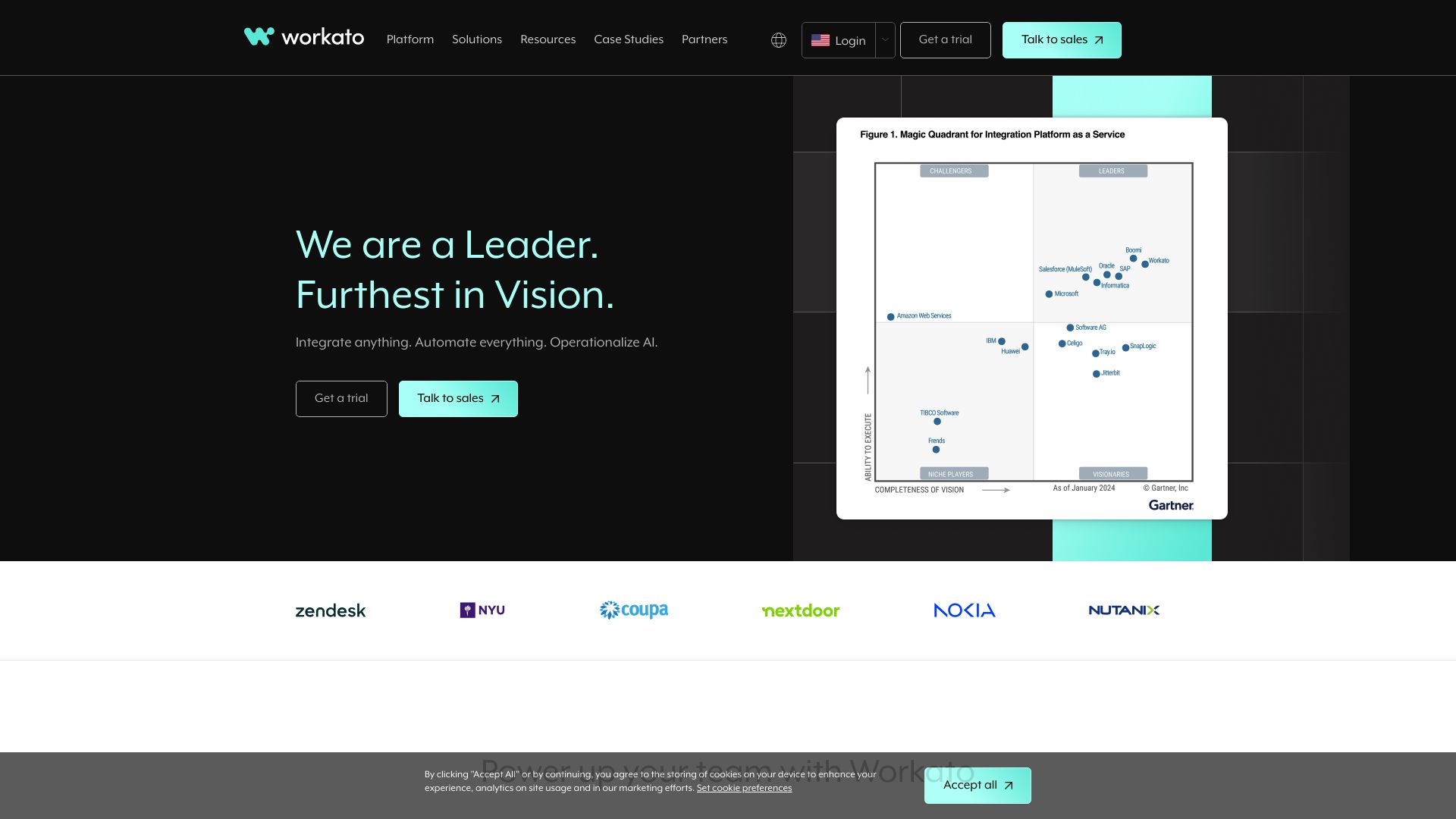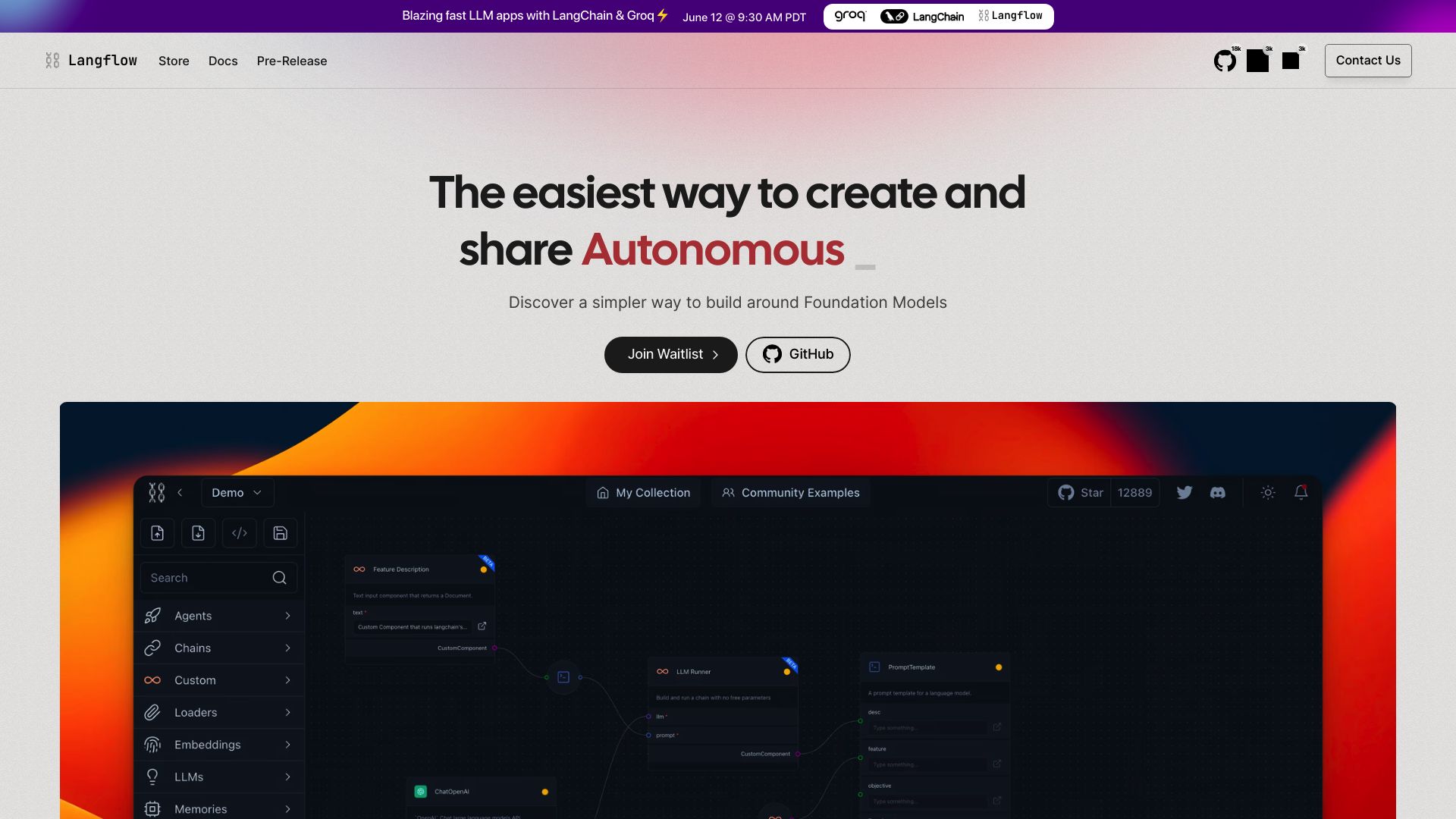Workato vs. Langflow: AI Workflow Automation Compared
The AI agent builder market brims with innovative solutions, each vying to streamline workflow automation and enhance productivity. This comparison delves into the capabilities of Workato vs. Langflow, and SmythOS, three distinct platforms reshaping how businesses leverage AI. Workato offers enterprise-grade automation with robust integrations, while Langflow focuses on simplifying AI application development through a visual interface.
SmythOS emerges as a versatile contender, combining powerful features with user-friendly design. We’ll explore how each platform tackles workflow creation, AI integration, and scalability, helping you determine which solution best aligns with your organization’s needs and technical expertise. Whether you’re a developer seeking advanced customization, a business leader focused on enterprise-wide implementation, or a non-technical user looking for accessible AI tools, this analysis provides the insights you need to make an informed decision.
Workato Overview
Workato harnesses the power of AI to revolutionize enterprise automation. This low-code/no-code platform enables businesses to create sophisticated workflows and integrations without extensive programming knowledge. Workato’s AI capabilities, developed in partnership with OpenAI, empower users to analyze text, categorize data, draft emails, and translate content seamlessly.
Workato harnesses the power of AI to revolutionize enterprise automation. This low-code/no-code platform enables businesses to create sophisticated workflows and integrations without extensive programming knowledge.


Workato excels in providing pre-built solutions and accelerators, such as the Knowledge Workbot Accelerator and Actions by Large Language Model. These tools facilitate rapid integration of knowledge bases and AI-driven actions within enterprise applications. The platform’s comprehensive approach combines data storage, user interface customization, and business logic in a unified ecosystem.
While Workato offers powerful features, users should be aware of certain limitations. The platform imposes rate limits on AI actions, restricting usage to 100 actions per workspace in a 24-hour period. Additionally, the lack of granular permission settings means all collaborators within a workspace have access to AI capabilities, regardless of their role.
Workato’s enterprise focus ensures scalability, security, and governance features suitable for large organizations with complex automation needs. However, smaller businesses or those with limited budgets may find the cost prohibitive. The platform’s marketplace boasts over 1,500 connectors and community recipes, fostering collaboration and enabling users to leverage existing solutions for their automation projects.
In the competitive landscape of AI agent builders, Workato stands out for its enterprise-grade capabilities and integration prowess. While it may not offer the same level of AI agent sophistication as some specialized platforms, its strength lies in combining automation, integration, and AI capabilities in a cohesive package for business users.
Langflow Overview
Langflow empowers developers to create and manage AI applications through an intuitive, low-code platform. This open-source tool simplifies the process of building complex AI workflows, making it accessible to users with varying levels of technical expertise.
The platform’s standout feature is its user-friendly interface, which allows for visual construction of AI workflows using drag-and-drop functionality. Langflow leverages pre-built LangChain components, including Large Language Models and agents, enabling users to prototype and experiment with ease. This approach significantly reduces the barrier to entry for AI development, allowing even those with limited coding experience to create sophisticated AI applications.
Langflow empowers developers to create and manage AI applications through an intuitive, low-code platform. This open-source tool simplifies the process of building complex AI workflows…


Langflow offers robust features beyond its visual interface. The platform provides a powerful Command-Line Interface (CLI) for advanced users, allowing granular control over project settings and configurations. Security is a priority, with enhanced login mechanisms and customizable user authentication options. The platform also supports API integration, enabling programmatic access to components and workflows, as well as asynchronous processing for efficient resource management.
One of Langflow’s key strengths lies in its customization potential. Users can create bespoke components using Python scripts, tailoring the platform to specific needs and integrating custom functionalities. This flexibility makes Langflow adaptable to a wide range of use cases across industries.
Users can create bespoke components using Python scripts, tailoring the platform to specific needs and integrating custom functionalities.
While Langflow offers significant advantages, potential users should consider certain factors. Despite its low-code approach, there may still be a learning curve for those entirely new to AI workflows. Additionally, while highly customizable, Langflow may not offer the same level of control as high-code solutions for extremely specific or complex requirements. Scalability for large-scale deployments and very intricate workflows might also be a consideration for enterprise users. Despite these potential limitations, Langflow remains a powerful tool for democratizing AI development, making it an attractive option for developers, businesses, and researchers looking to harness the power of AI in their projects.
Feature Comparison
Workato and Langflow offer distinct approaches to workflow automation and AI integration. Workato provides a comprehensive enterprise-focused platform with robust automation capabilities, while Langflow emphasizes low-code AI application development.
Workato excels in enterprise-grade features, offering extensive API integrations, scalable automations, and pre-built connectors for various business applications. Its AI capabilities, developed with OpenAI, enable text analysis, categorization, and email drafting. However, Workato imposes rate limits on AI actions and lacks granular permission settings for AI access within workspaces.
Langflow, as an open-source platform, focuses on simplifying AI workflow creation through a visual interface. It leverages LangChain components, including Large Language Models and agents, allowing users to prototype AI applications easily. Langflow’s strength lies in its customization potential, enabling users to create bespoke components with Python scripts. While Langflow offers significant flexibility, it may not match Workato’s enterprise-scale features and extensive pre-built integrations.
Feature Comparison Table
| Workato | Langflow | SmythOS | |
|---|---|---|---|
| CORE FEATURES | |||
| Autonomous Agents | ❌ | ✅ | ✅ |
| Multimodal | ❌ | ✅ | ✅ |
| Problem-Solving Capabilities | ✅ | ❌ | ✅ |
| Multi-Agent Collaboration | ❌ | ✅ | ✅ |
| Work as Team | ✅ | ❌ | ✅ |
| Bulk Work | ✅ | ❌ | ✅ |
| Agent Work Scheduler | ✅ | ❌ | ✅ |
| SECURITY | |||
| Constrained Alignment | ❌ | ✅ | ✅ |
| Data Encryption | ✅ | ❌ | ✅ |
| IP Control | ✅ | ❌ | ✅ |
| COMPONENTS | |||
| Foundation AIs | ✅ | ❌ | ✅ |
| Huggingface AIs | ❌ | ✅ | ✅ |
| Zapier APIs | ❌ | ✅ | ✅ |
| All other APIs, RPA | ✅ | ❌ | ✅ |
| Data Lakes | ❌ | ✅ | ✅ |
| DEPLOYMENT OPTIONS (EMBODIMENTS) | |||
| Deploy as API | ✅ | ❌ | ✅ |
| Production Domains | ✅ | ❌ | ✅ |
| API Authentication (OAuth + Key) | ✅ | ❌ | ✅ |
| Deploy as Site Chat | ✅ | ❌ | ✅ |
| Deploy as GPT | ✅ | ❌ | ✅ |
| DATA LAKE SUPPORT | |||
| Hosted Vector Database | ❌ | ✅ | ✅ |
| Sitemap Crawler | ❌ | ❌ | ✅ |
| YouTube Transcript Crawler | ❌ | ❌ | ✅ |
| URL Crawler | ❌ | ❌ | ✅ |
| PDF Support | ✅ | ❌ | ✅ |
Best Alternative to Workato and Langflow
SmythOS emerges as the superior alternative to Workato and Langflow for AI agent automation. We offer a comprehensive platform that combines ease of use with powerful features, catering to both technical and non-technical users.
Our drag-and-drop interface simplifies complex AI workflow creation, surpassing Workato’s enterprise-focused approach and Langflow’s open-source flexibility. SmythOS users build sophisticated AI agents without extensive coding knowledge, accelerating development and deployment.
SmythOS users build sophisticated AI agents without extensive coding knowledge, accelerating development and deployment.
Unlike Workato’s limited AI capabilities and Langflow’s focus on prototyping, SmythOS provides a complete ecosystem for AI agent development. We support autonomous agents, multi-agent collaboration, and problem-solving capabilities that outperform both competitors. Our platform integrates seamlessly with various AI models, APIs, and data sources, offering unparalleled versatility.
SmythOS excels in deployment options, a critical advantage over Workato and Langflow. We enable users to deploy AI agents as APIs, chatbots, scheduled tasks, or GPT models, accommodating diverse use cases across industries. This flexibility, combined with our robust security features and scalability, positions SmythOS as the ideal choice for businesses seeking to leverage AI technology effectively.
SmythOS excels in deployment options… We enable users to deploy AI agents as APIs, chatbots, scheduled tasks, or GPT models, accommodating diverse use cases across industries.
By choosing SmythOS, users gain access to a cutting-edge platform that addresses the limitations of both Workato and Langflow. We empower organizations to create, deploy, and manage AI agents with unprecedented ease and efficiency, driving innovation and productivity across the board.
Conclusion
Workato, Langflow, and SmythOS each offer unique approaches to AI-powered workflow automation, but SmythOS stands out as the superior choice for businesses seeking comprehensive AI integration.
Workato excels in enterprise-grade automation with robust API integrations and pre-built connectors. Its AI capabilities, developed with OpenAI, enable text analysis and email drafting. However, rate limits on AI actions and lack of granular permissions may constrain some users.
Langflow simplifies AI workflow creation through its open-source, visual interface. It leverages LangChain components for easy prototyping and offers significant customization potential. Yet, it may not match the enterprise-scale features of other platforms.
SmythOS emerges as the clear leader, combining the strengths of both while addressing their limitations. Its intuitive drag-and-drop interface democratizes AI development, making it accessible to technical and non-technical users alike. With support for over 300,000 integrations and compatibility with various AI models, SmythOS offers unparalleled flexibility and scalability.
Unlike its competitors, SmythOS provides a true “create once, deploy anywhere” experience, allowing users to build AI agents that seamlessly integrate across multiple platforms and services. This versatility, coupled with features like multi-agent orchestration and extensive deployment options, positions SmythOS as the most comprehensive solution for businesses looking to harness the full potential of AI.
For those ready to revolutionize their workflows and drive innovation through AI, we invite you to explore our diverse range of AI-powered agent templates or create a free SmythOS account to experience the future of AI automation firsthand. With SmythOS, you’re not just adopting a tool; you’re unlocking a new era of productivity and innovation for your business.
Last updated:
Disclaimer: The information presented in this article is for general informational purposes only and is provided as is. While we strive to keep the content up-to-date and accurate, we make no representations or warranties of any kind, express or implied, about the completeness, accuracy, reliability, suitability, or availability of the information contained in this article.
Any reliance you place on such information is strictly at your own risk. We reserve the right to make additions, deletions, or modifications to the contents of this article at any time without prior notice.
In no event will we be liable for any loss or damage including without limitation, indirect or consequential loss or damage, or any loss or damage whatsoever arising from loss of data, profits, or any other loss not specified herein arising out of, or in connection with, the use of this article.
Despite our best efforts, this article may contain oversights, errors, or omissions. If you notice any inaccuracies or have concerns about the content, please report them through our content feedback form. Your input helps us maintain the quality and reliability of our information.
